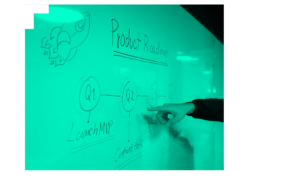Technology partnerships (aka software partnerships) make software development simple and easy… just make sure you know the basics before you choose a partner.

Are you promised reliable technology solutions, yet receive buggy and outdated platforms?
Sick of scope creep in stalled tech projects undermined by false promises?
If so, I feel you – it’s a sad state of affairs that undermines our whole industry.
A truly empowering strategic technology partnership would demonstrate the exact opposite!
Yet, it’s so easy to buy into a false economy.
Especially if you are unfamiliar with cutting-edge tech and require a complex solution fast.
To prevent the past from repeating itself, some simple tips can help you evaluate your choice of technology partner.
Here are the top tips from an expert with 10 years’ experience doing just that – managing software partnerships.
How Do I Choose A Software Partner?
#1 Seek out, cross-reference and test your potential software partner’s past projects.
#2 Ensure your strategic partner’s values and ethos align with your own.
#3 Foster open and proactive communication that accounts for change and ensures progress.
Past Results Reflect Future Possibilities
Your tech partner delivers inconsistent fixes with teams led by disorganized technology ‘experts’ ?
#1 Seek out, cross-reference, and test your potential technology partner’s past projects.
A track record of delivering consistently powerful platforms using modern tech solutions is a must. These speak for themselves. Look for case studies that are clearly and credibly outlined as a narrative. Well written too.
Case studies demonstrate that your potential partner knows how valuable their clients are, has maintained an ongoing relationship with them, and put the effort in to showcase the results of long-term teamwork.
Points To Consider In Any Software Case Study:
What was the problem, how was a direction and goal decided between both parties, and what was the workable solution?
- Download the tech – does it work?
- Are their technology solutions user-friendly?
- Were their software development solutions feasible and delivered in a realistic time frame?
- Did they consider long-term software maintenance?
In essence, here’s what you are looking for:
” Working with [company] was a valuable and successful partnership where we used [ x ] with [ y ] to build [ z ] resulting in [ a* ]. But to get to ‘z’ we had to work with our partner to make several compromises, such as [b, c, d] which we then incorporated into product development. Here’s the tech, we are proud that we worked together on this and it is still an effective piece of software or system today.”
A verified testimonial with quotes is a bonus. These really show commitment to a technology partnership – that company has taken time to interview and followup with their clients. To do that, they must have had an effective partnership built on respect and delivered their promise of an innovative software solution.
If these factors align, they point to consistency and repeatability in your potential partner’s process. It also suggests their core development capabilities are driven by a cohesive team of technology experts with defined roles.
They deliver and they care for the quality of their partnerships as well as the value in their technology projects.
Software Partners With Human-Centric Values.
Ever worked with a business so driven by the bottom line that they lost sight of your humanity?
Did you feel like a transaction?
#2 Ensure your strategic partner’s values and ethos are aligned with your own.
Delivery of bespoke Information Technology and Communication systems requires a leader who is capable of bringing out the best in their team. By doing so, their humanity resonates with their clients.
This is often the person who is the centre of a testimonial, yet their team will have earned the kind words and kudos too – by embodying the same values.
As a guide, ongoing accountability and responsibility conveyed through clear communication are great indicators of human-centric values. These need to be present from the beginning in any technology partnership as they form the basis of trust.
There are some stereotypes about technology consultants – lacking empathy and social skill, mainly. Regardless of the stereotype, make sure you meet a potential candidate in person so you can find out for yourself.
When you do, you will recognise the right strategic software partner within 20 minutes.
Trust your intuition – do you feel your value system and culture reflected and considered? There will be some kind of meaningful interaction, a fluidity in conversation and an unspoken resonance in the air – all of which signify that this person is a true reflection of those testimonials.
As alignment on partnership objectives is the result of human-centric values which promote trust and transparency, it’s paramount to work with the right person.
#1 + #2 = A technology partner that will work with you.
Are you up to speed?
Check out this free guide so you know where we’re coming from.
Measuring Performance In Software Development.
#3 Foster open, proactive communication that accounts for change and ensures progress.
Your values are aligned, their process considered and proven – now you really want to work with them… but how can you ensure ongoing performance?
Setting some clearly defined KPIs to benchmark and stamp progress is the most valuable tool to ensure just that – progress. Agree on realistic KPIs from the start by breaking the process into quantifiable chunks and discussing the resource required. Building tolerances into this roadmap ensures it is practical, especially if it’s a complex technology project.
Welcoming changing requirements to produce working software is the measure of flexibility in progress here. It is also a guiding principle which any strategic technology partner must follow. As such, you would expect a partner to build a change process into their mechanism and discuss it with you- foreseeing your ongoing requirements in any tech project.
Together, KPI’s and an agreed change process make for a formidable technology development system.
As well as objectives, please make sure to discuss your project in a way that considers both points of view. So that if aggravations arise, you are both on the same page.
Please ensure any frustrations are aired to your colleagues and confidants first. If they are validated, then – and only then – have the conversation with your tech partner in a measured and professional manner.
As a side note: agile principles are the cornerstone of any modern tech partnership.
The Checklist For Software Partnerships.
Do you have failed tech projects delivered in an untimely fashion by people who treat you as a transaction?
Seek a capable strategic technology partner who can combine measurable progress with human-centric leadership, and reflect your values. They will work with you to find reliable software solutions that boost your capabilities and enhance your technology systems with innovative digital solutions.
To do so:
#1 Seek out, cross-reference and test your potential software partner’s past projects.
#2 Ensure your strategic partner’s values and ethos align with your own.
#3 Foster open and proactive communication that accounts for change and ensures progress.
Think:
Clearly, this company values teamwork which compliments their development process and they stand behind their claims with their products & partners.
#1 + #2 x #3 ⇒
Past Results + Human Centric Values x Measurable Progress Incorporating Agile Principles =
Technology Partnership Built To Last.
See our other article to ensure you get the most from a software partnership.
Values. Strategic Partnership. Solutions. Progress. Success.
Greg Whitfield.
CEO Creative Stack.



